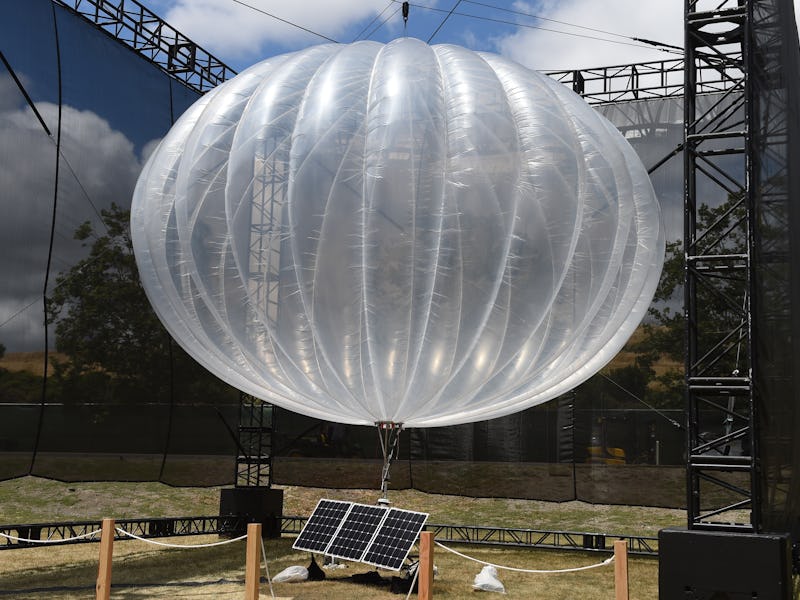After a successful Internet launch, here's where Loon is flying next
Balloon-based internet is currently flying high in Kenya, a win the Alphabet subsidiary. Here's what they're planning next.

Internet access in Kenya can now be accessed via high-flying balloons. Flying above planes, into the stratosphere, the balloons are the product of Loon, a company that has been putting years into this project. Here’s how they got here and what they're doing next.
Balloon internet? Balloon internet. Carrying Internet connections through balloons has been the nearly decade-long promise of Loon, which first started under the auspices of Google in 2011 and was eventually placed underneath the auspices of Alphabet, Google’s holding company.
What are these balloons? Fully inflated Loon balloons are around the size of a tennis court and are made up of polyethylene plastic, the same common material that can conveniently hold groceries. But instead of the latest fruits and vegetables, a Loon balloon holds cutting-edge technology. Chief among these are antennas that connect to stations on the ground, creating a mesh network with other balloons that comes across as a standard LTE connection for the user.
Alongside antennas are some basic flight equipment for command and control, solar panels for power, and a parachute in case of an emergency crash landing. But don’t expect a ride in these balloons, as they fly 12 miles up in the stratosphere, far above any commercial flight.
A Loon balloon taking flight.
How fast is it? According to Loon’s FAQ, tests have shown “internet speeds similar to that of current LTE/4G networks.”
Is it the full internet? Loon isn’t an Internet Service Provider or a cell company—both of those would require Alphabet to make large leaps. Rather, the plan is to partner with local telecom companies and expand their network. In Kenya, Alphabet has partnered with Telkom Kenya, the country’s third-largest service provider, to expand its network. Considering that 72 percent of Kenyans live in rural areas, according to the World Bank, the service could offer a considerable boost.
It’s something that President Uhuru Kenyatta is hoping for, which he reiterated in a Loon-assisted video call with Information Minister Joe Mucheru from the Great Rift Valley. “Now you will be able to sell your products on the internet. I want to see online sales of honey,” he said, referring to one of the region’s most popular exports.
Kenyan President Uhuru Kenyatta, seen here speaking at the United Nations. Kenyatta has been a major proponent of bringing Loon to rural Kenyans.
Telkom Kenya employees monitoring a Loon launch.
What’s in a name? The company’s name comes from how odd the suggestion seemed at first—Richard DeVaul, the progenitor of Loon, told Wired that his “colleagues had to believe I wasn’t completely on crack” when he first pitched the idea. DeVaul later left Alphabet after reports of sexual misconduct.
Who pays for it? The costs of Loon internet remain unclear. Neither Loon nor Telkom Kenya have divulged any monetary information about their deal. Back when the project was still under Google’s control in March 2015 (Alphabet was born in October 2015), a Loon executive imagined charging $5 a month from users across the globe, casting a wide net to earn billions.
However, no such plans have yet materialized.
Where is it going next? With its Kenyan launch a success, Loon is looking to expand its footprint in Africa. Earlier this year in May, Alphabet signed a deal with South African mobile operator Vodacom to expand into two particularly hard-to-reach regions of Mozambique. In December, the company reached an agreement to overflight rights in Uganda, a crucial step allowing for the balloons to be flown.
More balloons will likely appear around the world during moments of great crisis, as they did in Peru in 2019 48 hours after an earthquake. But the company has an eye towards permanent use.
Alastair Westgarth, Loon's CEO, wrote a Medium post after the company's successful Kenya launch describing a broader vision. He discusses the differences between a GPS and Wifi connection—one takes place at a geostationary level, over 21,700 miles from the Earth, and another at Low Earth Orbit (LEO) which happens at around 310 miles outside of the Earth's gravity.
Westgarth suggests the need for a third layer of connectivity, which he calls stratospheric. This new layer of connectivity could respond rapidly to service needs, with greater flexibility (if smaller range) than the two space-based locations.
"With the technologies we’ve built, Loon is well-positioned to play this role," Westgarth writes. "What we’re seeing in Kenya today is the laying of the foundation for a third layer of connectivity. It was a long time in the making, and there is still a lot of work to be done to establish this new layer of connectivity. But today we’re seeing the possibility of what the future can hold if we succeed."